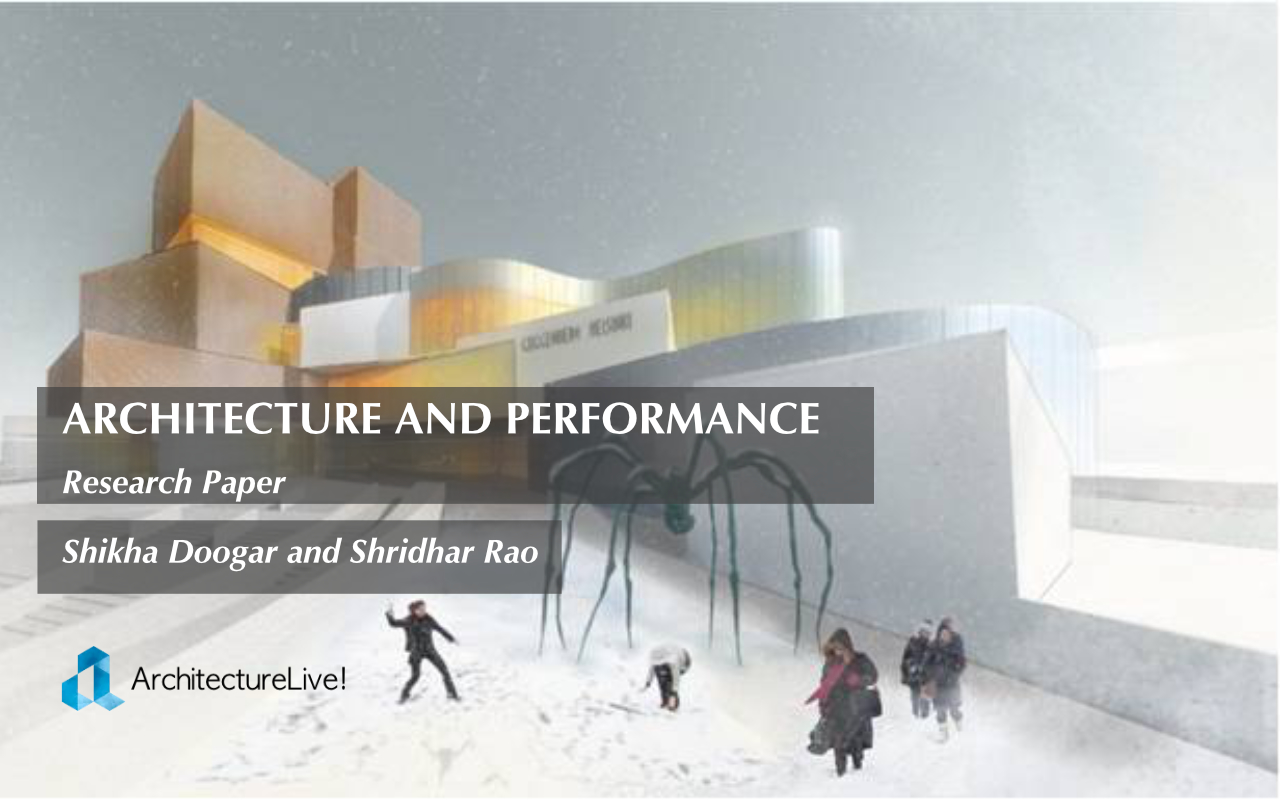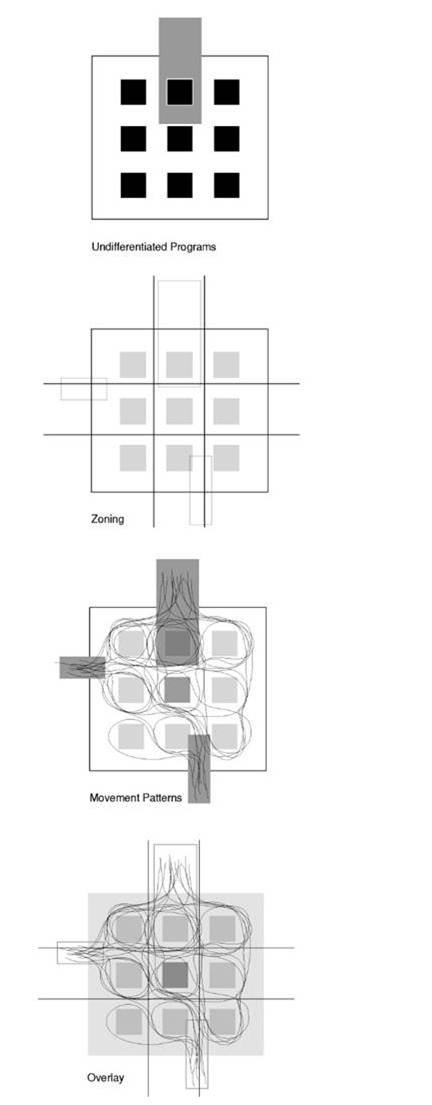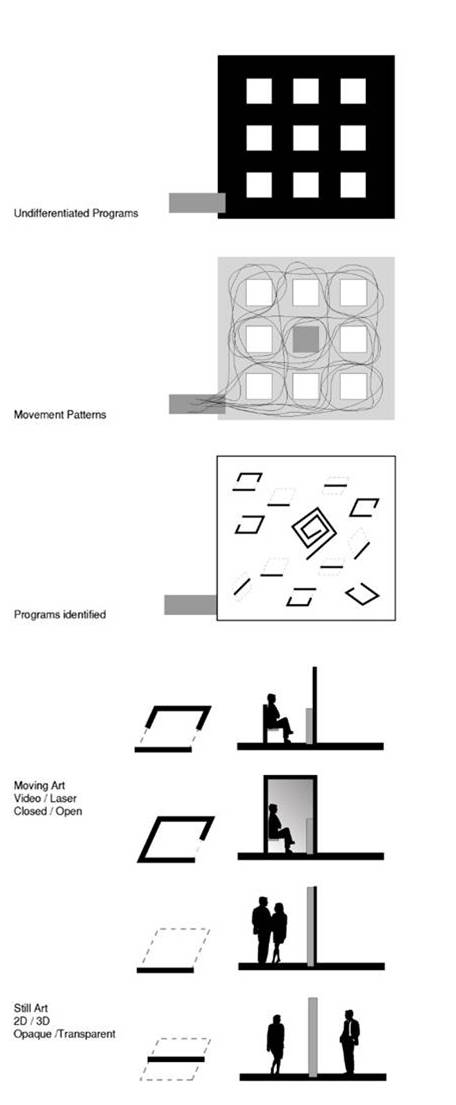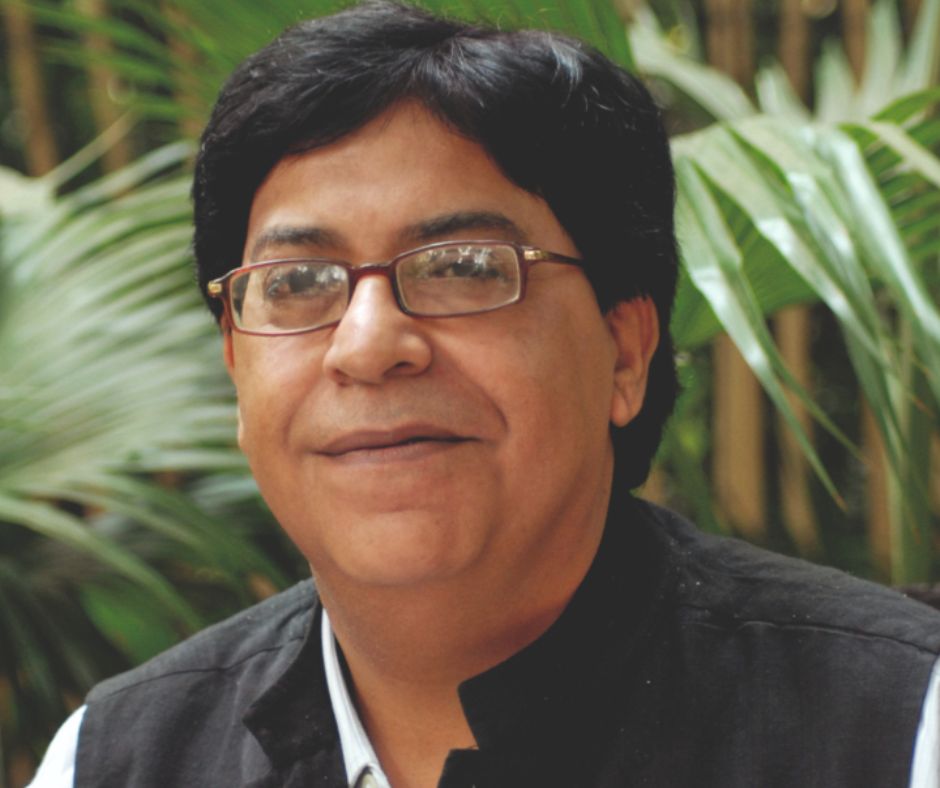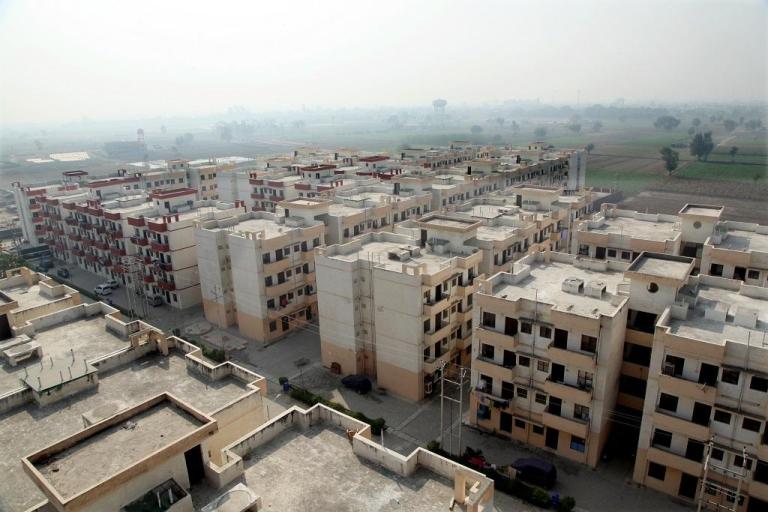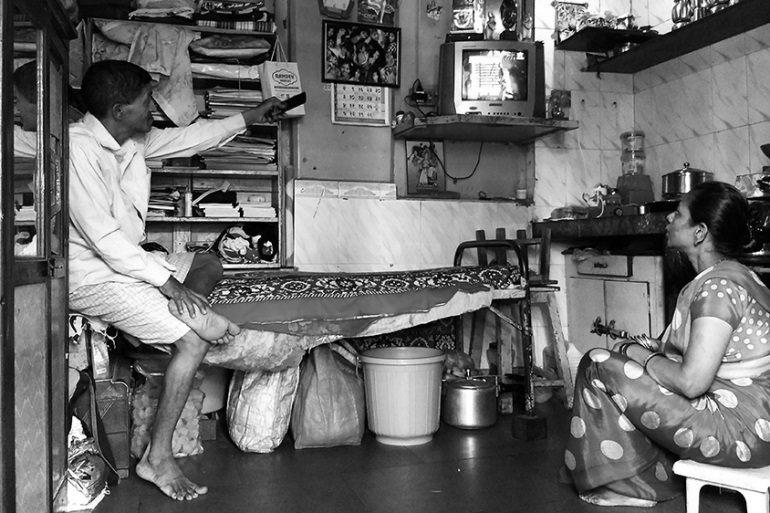ABSTRACT:
The idea of one ideal solution in architecture is a misnomer.
Our interest in performanceof program and place began when we were first introduced to the concept of Space and Event, during our period at Columbia University in 2000, when Bernard Tschumi was the Dean at GSSAP. Readings onRem Koolhaas’s theory of architecture and his contemporaries led to a new found interest in Place, Program and Process.Program has always been the start point for both academia and practice; and to merely treat it as a set of set requirements became debatable.It was apparent that program was always to be in questionfor its performa as architecture was a hybrid of form and function and alternatives in design was the key to its performance. Thus the discourse between form and function was rejected as it became obvious that architecture had to redefine its position in context and create a place that was inseparable from its program. Whether the form or function could be a start point to design or a resultant to the process, the hybrids had to be tested for alternates, which would define the performance of a building in time.
The paper represents how experience and occurrence in architecture has shaped our practice, wherein the program is questioned, mapped, interpreted and reinterpreted to maximise its performance both in form and function. The practiceis built on the exploration of three main aspectswhich become the basis of discourse in the presented paper:
- program v/s performance
- process v/s project
- architecture v/s identity
Keywords: architecture, event, space, performance, process, project, identity.
1. program v/s performance
Architecture is defined by the action it witnesses as much as by the enclosure of its walls. Murder in the street differs from Murder in the Cathedral in the same way as love in the street differs from Street of Love. Radically(Tschumi, 1996, p. 100).
Program can be defined as the DNA of design. A well-documented and detailed program is imperative to the process of design. The program is the brief that initiates the beginning of a project and establishes its initial identity. It mandates the description of client aspiration, tabulation of quantities and expansive specifications. Program defines but limits by nominalising the effect unless the program is constantly questioned and challenged within the framework of architecture.

Architecture is not simply about space and form, but also about event, action, and what happens in space. The Transcripts’ explicit purpose was to transcribe things normally removed from conventional architectural representation, namely the complex relationship between spaces and their use, between the set and the script, between “type” and “program,” between objects and events(Tschumi, 1995).
Phenomenology of space and its association to an act or multitude of acts is vital to the formation of a program brief and its translation into architecture. The multiple parameters that are enacted upon make the program enriching and enduring. Resultant is a performance brief versus a program brief which makes design tangible and corporeal.

To what extent could the literary narrative shed light on the organization of event in buildings, whether called “use”, “functions”, “activities”, or “program”? If writer’s could manipulate the structures of stories in the same way as they twist vocabulary and grammar, couldn’t architects do the same, organizing the program in a similar objective, detached, or imaginative way? For if architects could self-consciously use such devices as repetition, distortion, or juxtaposition in the formal elaboration of walls, couldn’t they do the same thing in terms of the activities that occurred within those very walls(Tschumi, 1996, p. 146)?
Arrangement of program can redefine the typology of a given space by mere choreography and juxtaposition of events without the challenging the nature it was intended for. Movement, logic and chance encounters test the performance of a program to transform it into a space of multiple events and opportunities. At the studio the program sheets are studied, discussed, reviewed and further discussed before one jumps to the drawing board. The program operates for a long time in the diagram mode, till all inter and intra relationships, dependencies and adjacencies are established. Multiple diagrams are created and considered for their performance factor. Understanding performa of a space not only reorganises architecture but adds viability to it. Performance is tested by understanding the user in depth and allowing different programs that operate on the fringes of architecture to affect. Parameters are re-formulated and re-programmed.


There is no architecture without action, no architecture without events, no architecture without program(Tschumi, 1996, p. 121).
Both Tschumi and Koolhaas promote programmatic instability in order to counteract architectural rigidity. Tschumi articulated this strategy in terms of what he described as cross-programming, trans-programming and dis-programming(Tschumi, 1996, p. 205)by mainly creating confrontations within the program. Confrontation adds complexity to the program, does not alter its purity but further enriches it. At no point can program be rejected over performance but techniques, methods and ways needs to be explored to activate the program beyond its ordinary use. Performative criteria become indispensable as a generator for architecture.

Architecture is a fuzzy amalgamation of ancient knowledge and contemporary practice, an awkward way to look at the world and an inadequate medium to operate on it. Any architectural project takes five years; no single enterprise – ambition, intention, need – remains unchanged in the contemporary maelstrom. Architecture is too slow. Yet the word ‘architecture’ is still pronounced with a certain reverence (outside the profession). It embodies the lingering hope – or the vague memory of a hope – that shape, form, coherence could be imposed on the violent surf of information that washes over us daily(AMO-OMA, et al., 2004, p. 20).
It is our belief at the studio that the architect does not independently create architecture but sets and ascertains the conditions from which it generates. Architecture needs to confer to experience and not be a product of a prosaic mind.
2. process v/s project
In the series Architecture and Limits, Tschumi touches upon the following “what is the unique character or essence of architecture as a discipline? Is it the use (function) or the process of the building?”
The idea of one superlative solution in architecture is a misnomer as the studio strongly believes that the process of architecture is iterative as well as perceptive. One generally begins with asking questions which then allows the proposed system to be more real. The more loaded the system, more probable is its viability. With advent of visualization tools exploration of design has found new dimensions. The multiple diagrams shape into multiple architectural solutions which metamorphose eventually into one single solution where all the rules initially established are still valid. A diagram oscillates between an abstraction to a more formal 2d and 3d representation till the performance of a space is tested and demonstrated.

With every project studio explores the dialogue between diagramming and physical model making and material within the design process. Techniques of diagramming are explored to not merely establish programmatic sequencing of various functions but create new and dynamic relationships which will induce tension within the traditional module.
Fig. 10. Concept Diagram –Combination resulting in resultant form – Watson’s Hotel, Competition Entry, 2008
A diagram is not a thing in itself but a description of potential relationships among elements, not only an abstract model of the way things behave in the world but a map of possible worlds(Allen, 1998).
Architecture needs to identify itself to a new paradigm. There is an exigency to reinvent the real purpose of a concept. Programmatic and conceptual juxtapositions allow for architecture that it is provocative, stimulating and elevating.
The concept of a building, however, can precede the insertion of program or content, since a neutral container can house a number of activities…the relationship between content and concept can be one of indifference, reciprocity, or conflict as well.(Tschumi, 2005)
Diagramming becomes the perfect tool, medium for this exploration as it does not commit yet establishes relationships and possibilities of actions within a defined or non-defined space. The diagram is no longer an auditory or visual archive but a map, a cartography that is coextensive with the whole social field. It is an abstract machine. It is described by its informal functions and matter in terms of form makes no distinction between content and expression, a discursive formation and a no –discursive formation. It is a machine that is almost blind and mute, even though it makes others see and speak(Deleuze, 1988).

Performance in architecture or an occurrence of an event in space can only be demonstrated through a series of actions. The diagram becomes a powerful tool as it feeds off the program and redefines it, reinterprets it. The starting brief is no longer a set of instruction but an overlap of programs and desires. The below steps have been tested both in academia and professional works to give variant results that are both powerful and dynamic in not only reorganising program but generating architecture. The strategy is to take an existing program, diagram its existing performance, investigate similar examples of program, map and re-interpret its performa based on accumulated information and eventually re-organize the diagram to redefine its architectural expression.
Step 1: Establish a program
Step 2: Organise a diagram for the program
Step 3: Identify additional program/forces/actions that compliments and contradicts
Step 4: De-stabilize / re-stabilize the diagram by establishing new relationships and adjacencies
Step 5: Repeat Steps 3-4 as necessary
Step 6: A new energised program which is represented as a dynamic and lithe diagram
Deleuze describes the diagram as the presentation of the relations between forces unique to a particular formation; it is the distribution of the power to affect and the power to be affected; it is the mixing of non-formalised pure functions and unformed pure matter(Deleuze & Guattari, 1987).

An abstract machine in itself is not physical or corporeal, any more than semiotic; it is diagrammatic….It operates by matter, not by substance; by function not by form….the diagrammatic or abstract machine does not function to represent…but rather constructs a real that is yet to come, a new type of reality(Deleuze & Guattari, 1987).
Process in architecture is key to the investigation of design; while there is an anomaly whether the project is prime,or the path that it travels to reach that position? Performance defines and enriches a program and process brings the project in motion and acts as aninitiator to design and architecture.One is forced to accept the notion of process when Stan Allen says “…the success of architecture is far more convincing when we can see the how and why behind design decisions.”He quite aptly puts it “Form matters, but not so much the form of things as the forms between things”(Allen, 1999).
Maybe architecture doesn’t have to be stupid after all. Liberated from the obligation to construct, it can become a way of thinking about anything – a discipline that represents relationships, proportions, connections, effects, the diagram of everything(AMO-OMA, et al., 2004).
Design for the studio has been a discourse about the exploration of design process and architecture as an object of desire versus the blur of possibilities that it wants to be. Diagramming is an essential tool in this quest as it collapses the dichotomy between representation and abstraction and allows for event to displace program. Mapping and reinterpretation act ancillary to the diagram giving rise to disparate strategies that arise from individual techniques which when arranged together create “a unique process for a unique program”.

3. architecture v/s identity
Architecture is repository of culture. It reflects its existence in time and is mostly associated with the built imagery of a building. Modern theory of form follows function gives more significance to absolute functions versus postmodern philosophy which polemically inverts the modernist dictum and pays more importance to the form. Historicallyalso, identity of a building has paid much relevance to the form, shape and size of a building. Conventionally accepted as the notion of identity, theorists like Bourdieu, Barthes and Foucault provided an alternate view to understanding the built form by suggesting that architectural identity is culturally, historically acquiescent and transformative in nature. They challenged the timeless depictions of the built environment and questioned the legitimacy of existing non-transformative notions of architectural meaning and value.

For instance, Bourdieu’s sociological concepts and notion of ‘habitus’(Bourdieu, 2002)arguesabout the fact that peoples interpretation of their environment are framed by their own knowledge, familiarized ideas and personal habitual experiences within their socio-cultural surroundings. On a similar note, Michel Foucaultemphasizes that meanings and ideas are definite to context of time both culturally and historically. In ‘The Order of Things’(Foucault, 1989), Foucault explains that people make sense of reality and ‘the wild profusion of existing things’ by ‘ordering’ or assigning it with meaning that has been discursively shaped within the specific context of their time. Similar ideas concerning the discontinuity of meaning are also expressed by Barthes in his essay ‘The Death of the Author’ (Roland, 1977), which criticises the supposition that an author has authority or ownership over the meaning of their textual work. He gives prominence to the reader in formalising his own interpretations and ideation of the text within a socio-cultural environment over the author’s personal intentions and reason for inscription. Conceptualization of the architect as the author and his architecture as the writings, Barthes emphasizes on the limited control that the earlier has in determining the meaning of a building within a social-cultural context.
Bernard Tschumiwho is seen as a counterpart to the philosophers mentioned above, stresses on the notion that architecture is “knowledge of form or a form of knowledge(Tschumi, 1980)”.His work suggests on the importance of content, concept and context and their dependencies on each other and vice-versa. The user of the space is absolute as he holds the ability to translate, transform or transgress the given program by establishing a performative criterion which is quintessential to generating a concept for architecture which needs to situate itself in or against context.
“There is no architecture without a concept-an overriding idea, diagram or parti that gives coherence and identity to a building. Concept, not form is what distinguishes architecture from mere building. There is also no architecture without context (except in utopia). A work of architecture is always in situ, or in situation, located on a site and within a setting. The context maybe historical, geographical, cultural, political or economic. Within architecture, content and context are inseparable(Tschumi, 2005).“Heargues that buildings may or may not conform to their setting but that the decision should always be strategic. Hence, concept, context, and content can work either in unison or in conflict. Context can generate architecture which is driven by the content or the content can activate the site and context by adopting conceptual strategies that can be either generative, reactionary of superimposed. Context provides constraints and parameters to test the program while content can test the limits of the site.
Content = Space/Event Concept = Diagram Context = Place
The site grounds architecture and adds complexity to the content by creating a symptomatic relationship between the building and its context;that every design needs to engage with its ecology and identify with its milieu. Architecture is no longer defined by its form but how it performs in a given time and place.
When the outcome drives the process we will only ever go to where we’ve already been. If process drives the outcome we may not know where we’re going; but we will know we want to be there(Mau, 1998).
The process of understanding the program brief and processing it into performance brief is as important as understanding the site and its context and processing it into “Place making”. The practice engages in the idea of creating a place for its architecture versus merely situating it on a site or expressing it in formal identity. Place allows the architecture to belong, to become a phenomenon, an event. Christian Norberg- Schulz maintains that meaning in architecture occurs when a building possess a sense of place. Architecture gathers meaning when the crux of space and place is human activity which through diagrams consent to the investigation and materialization of concepts.

A place is therefore a qualitative, “total” phenomenon, which we cannot reduce to any of its properties, such as spatial relationship, without losing its concrete nature out of sight(Schulz, 1988).There is no doubt that the form of the city is undergoing a mutation; and further new configurations and urban effects are emerging more rapidly than the ability of the disciplines of architecture or planning to theorize and understand them, much less exercise any kind of rational control…Much recent theory of the city has focussed on mapping the effects of these ineffable factors, understanding the city as an interconnected network of circuits and exchanges, mirroring power relationships and political spaces(Allen, 2003).
Architecture can associate with the city in ways not available to other fields of practices such as art, literature, politics etc, the practice engages in the constraints of program relationships, movement logic, and site parameters to examine and re-imagine the engagement between architecture and its urban context to construct a new typological destination.
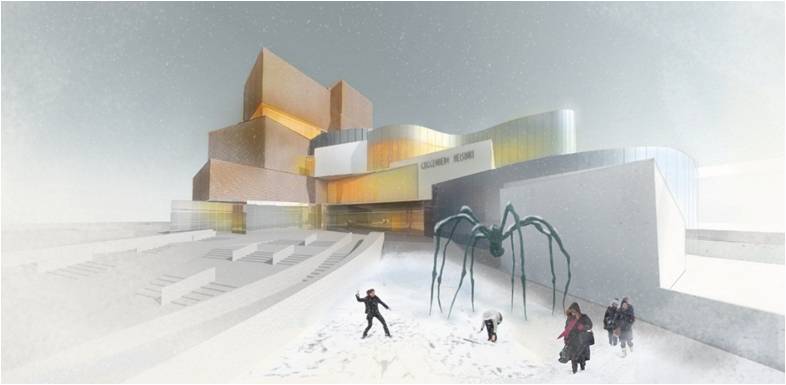
Architecture is a collaborative art form and the practice of architecture an amalgamation of client aspiration, creative thinking and a mosaic of structure and services superimposed. The studio seeks opportunities within the program and engages in processes that tests performance, experience and flexibility along with accountability, productivity and liability. Through the paper we have tried to present ways the practice engages in the production of architecture and institutes that the means to design is the performance of space, place in time. Identity of a building is not so much about the formal expression or shape but about the place it creates for its self through phenomenology.
Bibliography
Allen, S., 1998. Diagram Matters. ANY:Architecture, no 23, pp. 16-19.
Allen, S., 1999. Points + Lines : Diagrams and Projects for the City. New York: Princeton Architectural Press.
Allen, S., 2003. City/Index Architecture. Cambridge: The MIT Press.
AMO-OMA, Koolhaas, R. &&&&, 2004. Content. s.l.:Taschen.
Bourdieu, P., 2002. In Habitus: A Sense of Place. Burlington: Ashgate Publishing Limited.
Deleuze, G., 1988. Foucault. s.l.:The Athlone Press.
Deleuze, G. & Guattari, F., 1987. A Thousand Plateaus: Capitalism and Schizophrenia. s.l.:University of Minnesota Press.
Foucault, M., 1989. The Order of Things: An archeology of the human sciences. London: Routledge.
Mau, B., 1998. Incomplete Manifesto for Growth. s.l.:s.n.
Norberg-Schulz, C., 1976. Essay, The Phenomenon Of Place. s.l.:s.n.
Roland, B., 1977. The Death of the Author. Glasgow:Fontana: s.n.
Schulz, C. N., 1988. The Phenomenon of Place. New York: Princeton Architectural Press.
Tschumi, B., 1980. Architecture and Limits 1. ArtForum.
Tschumi, B., 1995. The Manhattan Transcripts: Theoretical Projects (1976-1981). s.l.:St.Martin’s Press/Academy Edition.
Tschumi, B., 1996. Architecture and Disjunction. s.l.:The MIT Press.
Tschumi, B., 1996. Architecture and Disjunction. Cambridge/London: The MIT Press.
Tschumi, B., 2005. Event Cities-3: concept vs. Context vs. Content. Cambridge: MIT Press.
Tschumi, B., 2005. Event-Cities 3. Cambridge: MIT Press.
Shikha Doogar
Founding Partner, r+d studio (www.rdstudio.net)
Visiting Faculty, Sushant School of Art & Architecture
MSAAD, Columbia University, City of New York
Shridhar Rao
Partner, r+d studio (www.rdstudio.net)
Visiting Faculty, Sushant School of Art & Architecture
MSAAD, Columbia University, City of New York

